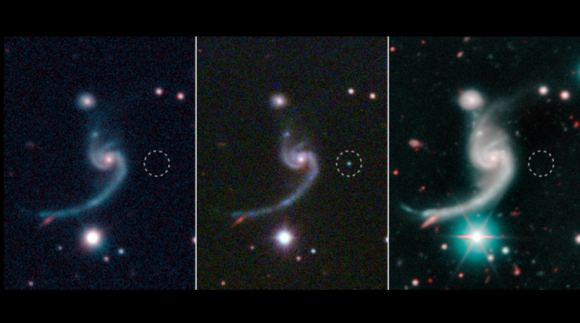For almost a century, astronomers have been studying supernovae with great interest. These miraculous events are what take place when a star enters the final phase of its lifespan and collapses, or is stripped by a companion star of its outer layers to the point where it undergoes core collapse. In both cases, this event usually leads to a massive release of material a few times the mass of our Sun.
However, an international team of scientists recently witnessed a supernova that was a surprisingly faint and brief. Their observations indicate that the supernova was caused by an unseen companion, likely a neutron star that stripped its companion of material, causing it to collapse and go supernova. This is therefore the first time that scientists have witnessed the birth of a compact neutron star binary system.
The study, titled “A hot and fast ultra-stripped supernova that likely formed a compact neutron star binary“, recently appeared in the journal Science. The study was led by Kishalay De, a graduate student from Caltech’s Department of Astrophysics, and included members from the NASA Goddard Space Flight Center and Jet Propulsion Laboratory, The Weizmann Institute of Science, the Max Planck Institute for Astrophysics, the Lawrence Berkeley National Laboratory, and multiple universities and observatories.

The team’s research was conducted primarily in the laboratory of Mansi Kasliwal, an assistant professor of astronomy at Caltech and a co-author on the study. She is also the principal investigator of the Caltech-led Global Relay of Observatories Watching Transients Happen (GROWTH) project, an international astronomical collaboration that is focused on studying the physics of transient (short-lived) events – i.e. supernovae, neutron stars, black hole mergers, and near-earth asteroids.
For the sake of their study, the team observed the supernova event known as iPTF 14gqr, which appeared in the outskirts of a spiral galaxy about 920 million light years from Earth. In the course of their observations, they noticed that the supernova resulted in the release of a comparably modest amount of matter – about one fifth of the mass of the Sun. This was quite the surprise, as Kasliwali indicated in a recent Caltech press release:
“We saw this massive star’s core collapse, but we saw remarkably little mass ejected. We call this an ultra-stripped envelope supernova and it has long been predicted that they exist. This is the first time we have convincingly seen core collapse of a massive star that is so devoid of matter.”
This event was unusual because, in order for stars to collapse, their cores need to have been enveloped by massive amounts of material beforehand. This raised the question of where the stars missing mass could have gone. Based on their observations, they determined that a compact companion (either a white dwarf or a neutron star) must have siphoned it off over time.

This scenario is what leads to Type I supernovae, which occur in binary system consisting of a neutron star and a red giant. In this case, the team could not spot the neutron star companion, but reasoned that it must have formed in orbit with the other star, thus forming the original binary system. In effect, this means that by observing iPTF 14gqr, the team witnessed the birth of a binary system made up of two compact neutron stars.
What’s more, the fact that these two neutron stars are so close together means that they will eventually merge in an event similar to the one that took place in 2017. Known as the “kilonova event“, this merger was the first cosmic event to be viewed in both gravitational and electromagnetic waves. Follow-up observations also indicated that the merger likely resulted in the formation of a black hole.
This creates opportunities for future surveys, which will be watching iPTF 14gqr to see if another kilonova event results and creates another black hole. On top of all that, the fact that the team was able to observe the event at all was quite fortunate, given that these phenomena are both rare (accounting for just 1% of supernova events) and short-lived. As De explained:
“You need fast transient surveys and a well-coordinated network of astronomers worldwide to really capture the early phase of a supernova. Without data in its infancy, we could not have concluded that the explosion must have originated in the collapsing core of a massive star with an envelope about 500 times the radius of the sun.”

The event was first detected by the Palomar Observatory as part of the intermediate Palomar Transient Factory (iPTF) – a scientific collaboration where observatories around the world monitor the cosmos for short-lived cosmic events like supernovae. Thanks to the iPTF conducting nightly surveys, the Palomar telescope was able to spot iPTF 14gqr very shortly after it went supernova.
The collaboration also ensured that once the Palomar Telescope was no longer able to see it (due to Earth’s rotation) that other observatories were able to keep monitoring it and track its evolution. Looking ahead, the Zwicky Transient Facility (which is the successor to the Palomar Observatory for the iPTF) will be conducting even more frequent and broad surveys of the sky, hoping to spot more of these rare events.
These surveys, in coordination with follow-up efforts by networks like GROWTH, will allow astronomers to study how compact binary systems evolve. This will lead to a greater understand of not only how these objects interact, but provide more insight into how gravitational waves and certain types of black holes are formed.

